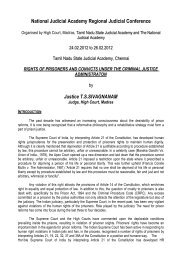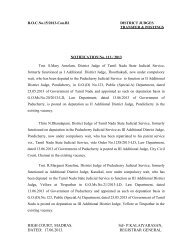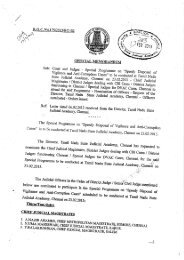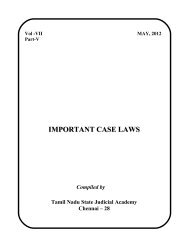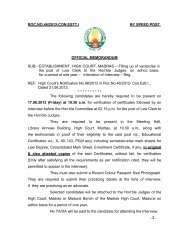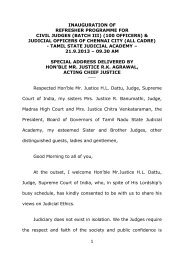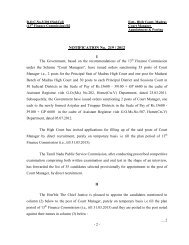Appreciation of Evidence in Sessions Cases - Justice D.Murugesan
Appreciation of Evidence in Sessions Cases - Justice D.Murugesan
Appreciation of Evidence in Sessions Cases - Justice D.Murugesan
Create successful ePaper yourself
Turn your PDF publications into a flip-book with our unique Google optimized e-Paper software.
Para 21. At one time it was held that the expression “fact discovered” <strong>in</strong> the section is restricted to<br />
a physical or material fact which can be perceived by the senses, and that it does not <strong>in</strong>clude a mental fact,<br />
now it is fairly settled that the expression “fact discovered” <strong>in</strong>cludes not only the physical object produced,<br />
but also the place from which it is produced and the knowledge <strong>of</strong> the accused as to this, as noted <strong>in</strong><br />
Palukuri Kotayya v.. Emperor (AIR 1947 PC 67) and <strong>in</strong> UDAI BHAN v.. STATE OF UTTAR PRADESH<br />
[MANU/SC/0144/1962].<br />
Para 22. The various requirements <strong>of</strong> the Section can be summed up as follows:<br />
(1) The fact <strong>of</strong> which evidence is sought to be given must be relevant to the issue. It must be<br />
borne <strong>in</strong> m<strong>in</strong>d that the provision has noth<strong>in</strong>g to do with question <strong>of</strong> relevancy. The relevancy <strong>of</strong><br />
the fact discovered must be established accord<strong>in</strong>g to the prescriptions relat<strong>in</strong>g to relevancy <strong>of</strong><br />
other evidence connect<strong>in</strong>g it with the crime <strong>in</strong> order to make the fact discovered admissible.<br />
(2) The fact must have been discovered.<br />
(3) The discovery must have been <strong>in</strong> consequence <strong>of</strong> some <strong>in</strong>formation received from the<br />
accused and not by accused’s own act.<br />
(4) The persons giv<strong>in</strong>g the <strong>in</strong>formation must be accused <strong>of</strong> any <strong>of</strong>fence.<br />
(5) He must be <strong>in</strong> the custody <strong>of</strong> a police <strong>of</strong>ficer.<br />
(6) The discovery <strong>of</strong> a fact <strong>in</strong> consequence <strong>of</strong> <strong>in</strong>formation received from an accused <strong>in</strong> custody<br />
must be deposed to.<br />
(7) Thereupon only that portion <strong>of</strong> the <strong>in</strong>formation which relates dist<strong>in</strong>ctly or strictly to the fact<br />
discovered can be proved. The rest is <strong>in</strong>admissible.<br />
As observed <strong>in</strong> Palukuri Kotayya’s case it can seldom happen that <strong>in</strong>formation lead<strong>in</strong>g to the discovery <strong>of</strong> a<br />
fact forms the foundation <strong>of</strong> the prosecution case. It is one l<strong>in</strong>k <strong>in</strong> the cha<strong>in</strong> <strong>of</strong> pro<strong>of</strong> and the other l<strong>in</strong>ks<br />
must be forged <strong>in</strong> manner allowed by law. To similar effect was the view expressed <strong>in</strong> K.Ch<strong>in</strong>naswamy<br />
Reddy V.. State <strong>of</strong> Andha Pradesh and Anr. [MANU/SC/0133/1962].<br />
(c). Recovery <strong>of</strong> <strong>in</strong>crim<strong>in</strong>at<strong>in</strong>g articles:-<br />
Section 27 – Recovery <strong>of</strong> <strong>in</strong>crim<strong>in</strong>at<strong>in</strong>g articles – From place which is open and accessible to others<br />
– <strong>Evidence</strong> under S. 27 would not be vitiated on that ground.<br />
There is noth<strong>in</strong>g <strong>in</strong> Section 27 <strong>of</strong> the <strong>Evidence</strong> Act which renders the statement <strong>of</strong> the accused<br />
<strong>in</strong>admissible if recovery <strong>of</strong> the articles are made from any place which is “open or accessible to others”. It is<br />
a fallacious notion when recovery <strong>of</strong> any <strong>in</strong>crim<strong>in</strong>at<strong>in</strong>g article was made from a place which is open or<br />
accessible to others it would vitiate the evidence under section 27 <strong>of</strong> the <strong>Evidence</strong> Act. Any object can be<br />
concealed <strong>in</strong> places which are open or accessible to others. For example, if the article is buried on the ma<strong>in</strong><br />
roadside or if it is concealed, beneath dry leaves ly<strong>in</strong>g on public places or kept hidden <strong>in</strong> a public <strong>of</strong>fice, the<br />
article would rema<strong>in</strong> out <strong>of</strong> the visibility <strong>of</strong> others <strong>in</strong> normal circumstances. Until such article is dis<strong>in</strong>terred its<br />
hidden state would rema<strong>in</strong> unhampered. The person who hid it alone knows where it is until he discloses<br />
the fact to any other person. Hence the crucial question is not whether the place was accessible to others<br />
or not but whether it was ord<strong>in</strong>arily visible to others. If it is not, then it is immaterial that the concealed place<br />
is accessible to others.<br />
19



